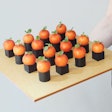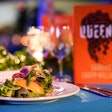
2017 hasn’t exactly been a banner year for new food festivals. BrunchCon in New York made headlines in March for being a crowded and disorganized event that left guests waiting in line for hours to get little to no food. One of the many reasons the infamous Fyre Festival in April went viral was because of a photo of a cheese sandwich that was the opposite of the fancy cuisine that was promised (though it turned out that the sandwich was actually served to festival staff). And most recently, the New York City Pizza Festival proved to be a ripoff for attendees, as the only pizza served was in the form of cold, smaller-than-sample size slices.
With new food festivals making headlines for the wrong reasons, BizBash spoke with a few event producers who offered their tips on how to avoid creating a disaster of Fyre Fest-level proportions.
Manage entry time slots. Miraya Berke, one of the co-founders of the New York’s Instagram-friendly Dessert Goals and owner of Pop Productions event studio, says that having multiple entry times is a key to hosting a successful food event. “We set up the format of Dessert Goals so attendees purchase tickets for a one-and-a-half hour time slot,” she says. “This helps us control how many people are in the space at a time for optimal ratio of attendees and vendors, to keep lines short.”
Create a floorpan with the biggest draw in the furthest corner. Caryl Chinn, founder of Los Angeles-based Caryl Chinn Culinary Consulting, notes the importance of being strategic in where to place vendors in the venue. “For the All-Star Chef Classic in March, we placed the wildly popular Howlin’ Rays away from the entrance,” she says. “As expected, they had a line all night, but it really helped pull people into that corner. And to their credit, they were serving fried chicken until a few minutes after the event ended, with big smiles.”
Don't put a novice near the entrance. Chinn also stresses the importance of vendor placement. “Place a seasoned veteran near the entrance—someone who will be able to handle a heavy volume and demand from the minute the doors open. If it’s a less experienced chef, or one who’s chosen to serve a complicated dish, their line will be slow and back up your entryway,” explains Chinn. “There is sort of a feeding frenzy mentality that takes over when people walk into an event. I find if people can quickly get a bite or a drink as soon as they arrive, then they relax a little and will be able to explore the rest of the event at a more leisurely pace.”
Keep attendees entertained. While the main draw of food and drink events is the bites and beverages, additional entertainment can be a necessary alternative for guests who need a break. Kate Levenstien, C.E.O. of Cannonball Productions—an event production company that hosts coast-to-coast food and beverage events including the Bacon and Beer Classic, Whiskey Feast, and the Taco Takeover—says it’s important to have additional entertainment such as games, demonstrations, music, and contests. “When we have 10,000 people attend an event, we’re not sure why everyone is there,” she says. “They could be there for a variety of reasons. We try and have a range of activities and activations going on for people to engage with.”
Choose the right vendors. When it comes to food festivals, selecting a vendor that fits for a particular event can be crucial. “We speak with each of our vendors on a call to talk through the format of the event and answer questions before they sign on to Dessert Goals,” says Berke. “We want to make sure the vendors are a good fit for Dessert Goals, and that Dessert Goals is a good fit for the vendor’s goals.”
Keep constant communication with vendors. Berke also notes that communicating with vendors on a regular basis leading up to the event is important. “As the organizers of the event, we communicate with our vendors by sending regular updates on ticket sales, attendees, collaboration opportunities, and tips for sales,” she says. “We encourage vendors to experiment and sell special items, and instruct them to ration their products so they have inventory to sell at each time slot of the day.”
Prepare vendors as much as possible. Levenstien says that her team has a good amount of back-and-forth with vendors, especially if it’s their first time participating in a food festival. “[We go over] how big the samples sizes should be and how many staff they’ll need to have to execute in an efficient manner,” she says. “Whenever we see a line, it’s usually because they’re understaffed or making a dish that might be too complex to create onsite. We try and work with them ahead of time.”
Partner with a local organization to fight food waste. Chinn notes that the event industry can be a big offender when it comes to wasting food. “Identify a local group that will pick up any leftover food and get it to a shelter that can take it,” she says. “In Los Angeles, I work with Chefs to End Hunger, which provides storage pans with covers and guidelines for how to store and label food properly, and what [type of food] they can take.”
Look at your ratios. Levenstien says the most important thing to know when planning a food festival is your event ratio. “[Vendors] need to know the number of attendees per booth, how long the lines will be, and how many samples they’ll need,” says Levenstien. “A number we usually go off of is, at most, 50 people per booth.”
Chinn also adds to the importance of calculating ratios and thinking about how many points of service there will be at an event. “Ten chefs servicing 1,000 guests equals 100 guests per line and 40 chefs serving 1,000 guests equals 25 guests per line,” she says. “Obviously this is over-simplified and doesn’t take into account guests mingling or getting a drink, but it helps me visualize how many chefs I want to participate in an event.”


















